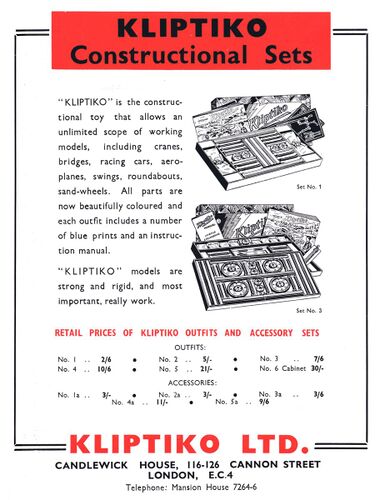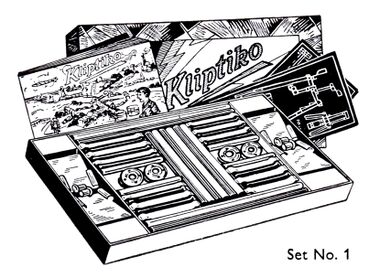Category:Kliptiko
| Toy Brands and Manufacturers |
|---|
Kliptiko |
| 1913 - |
1939: Full-page advert in Games and Toys [image info]
1939: Kliptiko Srt No.1 [image info]
Kliptiko was a metal construction toy created just before the start of World War One, which allowed users to clip together a framework of metal tubes and other pieces to make shapes, in a manner similar to the "hand-clasp" clips used to attach scaffolding tubes together at right-angles.
It seems that it might have been the first proper product by William Bailey of Birmingham, who went on to create and patent the clip-together "model building construction" sets, Wenebrik, in 1915.
Bailey partnered with Farnell in 1932 with respect to marketing.
By 1939 there were six main sets in the range (with set No.6 coming in its own wooden cabinet), and also accessory sets 1a-5a.
1920 promotional text:
KLIPTIKO: The simplest of all the great constructional toys, as no screws are used, and the only tools required are the fingers.
A KLIPTIKO outfit is a proud possession for any boy. It affords him all the apparatus for building bridges, towers, cranes, sand wheels, roundabouts, and many other structural and mechanical things. In fact, the possibilities of KLIPTIKO are practically unlimited. What a vista of happy experiment and gratifying achievement lies open to the KLIPTIKO boy!
The splendid toy derives its name from the fact that all the pieces clip together. No screws or screwdrivers wanted, and if a piece should get lost the set is not spoiled, as with some toys. The pieces are clipped together very easily, yet a complete structure such as the Eiffel Tower on this page is quite rigid and can be carried about.
KLIPTIKO is much more than a toy. It is a practical educator for all boys, and a boon to a “budding” engineer. A toy that is so wide in its scope, so instructional while being amusing, so suggestive of ideas, is really a necessity for the fullest happiness of the rising generation.
1939 promotional text:
"KLIPTIKO" is the constructional toy that allows an unlimited scope of working models, including cranes, bridges, racing cars, aeroplanes, swings, roundabouts, sand-wheels. All parts are now beautifully coloured and each outfit includes a number of blue prints and an instruction manual.
"KLIPTIKO" models are strong and rigid, and most important, really work.
Patent
The system's patent was applied for on 24th April 1913, and granted on 14th August 1913, to Henry Charles Harrison, of Stoneleigh, Mayfield Road, Moseley, Birmingham (Manufacturer).
This invention relates to elements employed for building toy structures such as toy bridges, cranes, and other objects, the said elements being that of the type consisting of lengths of tubing provided at one or both ends with a clip or clips whereby they may be detachably or interchangeably connected together.
External links
Pages in category ‘Kliptiko’
The following 2 pages are in this category, out of 2 total.
Media in category ‘Kliptiko’
The following 3 files are in this category, out of 3 total.
- Kliptiko (GaT 1939-04).jpg 912 × 1,200; 172 KB
- Kliptiko Set No1 (GaT 1939-04).jpg 1,657 × 1,213; 314 KB
- Kliptiko Set No3 (GaT 1939-04).jpg 1,577 × 1,319; 447 KB








